Florida, with its shimmering beaches and its many tourist attractions, holds a hidden nocturnal secret. Nestled within its woodlands, and sometimes even peeking out from local parks and backyards, are the mesmerizing owls of the region. As twilight descends, these mystical birds emerge, their haunting calls echoing through the air. Out of the 19 owls found in North America, you can see a total of 11 in Florida.
In this article, we will first delve into the mysteries of the rarest owls to grace Florida’s skies before introducing you to the more common owl species. So, whether you’re a dedicated bird watcher or just someone enthralled by these enigmatic birds, let’s discover these wise birds together!
Rare Owls in Florida
Below are the rare owl species in Florida.
1. Snowy Owl (Bubo scandiacus)

While snowy owls are definitely not very common in Florida, you may find one if you’re super lucky.
©Carol Gray/iStock via Getty Images
The snowy owl is a beautifully striking bird, mostly because of its bright white feathers, which are adorned with dark patches and lines. Male snowy owls tend to have clearer, almost pristine white coats, while females, often have more dark patterning and a hint of a brownish tint. Female snowy owls are generally larger than their male counterparts. In terms of size, snowy owls stand tall at about 20 to 28 inches. Additionally, they boast a massive span of 4 to 5 feet. These impressive birds have a lifespan of 10 years but can live a long 23 years in the wild.
Snowy owls have a pretty diverse diet, eating mice, Arctic hares, ducks, and even seabirds.
Now, although you wouldn’t usually find these birds sunbathing in Florida, some snowy owls do make an unexpected visit there. After all, these owls are more accustomed to the cool summer climes of northern Alaska and Canada. In some winters, some snowy owls may move south of their breeding grounds, often appearing in places where they normally wouldn’t be found. As you can see, spotting one in Florida is quite an unusual and special event. So, if you’re in Florida and you happen to see one of these majestic creatures, consider yourself incredibly lucky!
2. Northern Saw-Whet Owl (Aegolius acadicus)
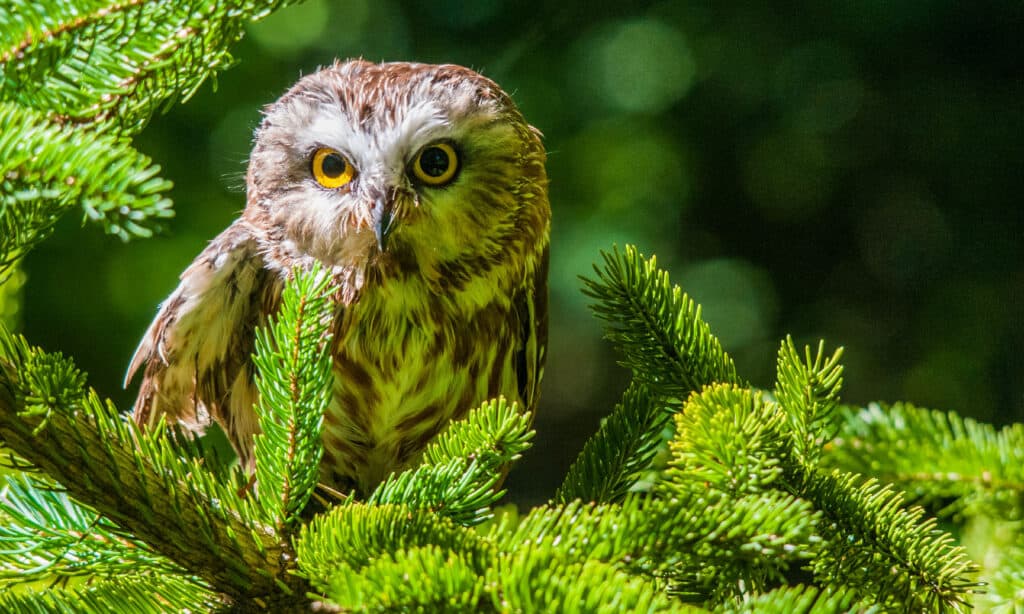
Another rare owl you might spot in Florida is the northern saw-whet owl.
©iStock.com/bookguy
The northern saw-whet owl is a tiny yet captivating creature with a short, stout body and a notably big, round head. This owl’s feathers, a rich shade of brown, are beautifully speckled with tiny white dots and splashes. On its face, right between its bright yellow eyes, there’s a distinctive white Y-mark, which pops out against a lighter brown background. As mentioned, these owls aren’t very big. In fact, they usually measure just 7 to 9 inches in length and have wings that stretch between 16.5 to 22 inches.
While northern saw-whet owls mostly live in pine forests up north, in places like Alaska, Canada, and northern and western parts of the USA, they sometimes come down to the Florida woods in the winter. Amazingly, these owls can hunt and detect prey with just their ears; their nocturnal nature and sharp ears help them hear tiny critters like rodents. While they mostly feed on mice that live in forests, these owls will also eat young squirrels, small birds, and even insects! Their peculiar name comes from their repetitive hoot that sounds a lot like sharpening a saw on a whetstone.
If you’re in Florida and you happen to spot a northern saw-whet owl, consider yourself really lucky. These owls mainly show up in the northern and western states during colder months, making them a rare sight in Florida. To spot one, you’ll really have to search hard, not only due to its rarity but also because its brown feathers make it quite hard to find.
3. Stygian Owl (Asio stygius)
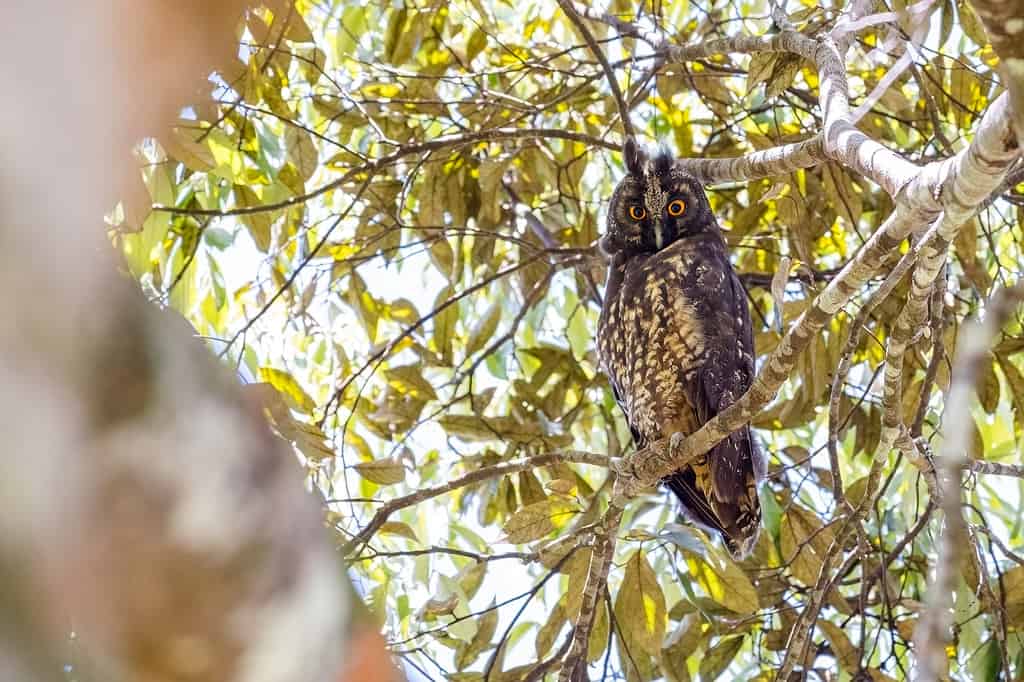
A medium-sized bird, the Stygian owl is mostly found in Mexico but may occasionally wander to Florida.
©J Esteban Berrio/iStock via Getty Images
The Stygian owl is a dark and medium-sized bird, mainly found in Mexico all the way down to South America. Standing roughly 15 to 18 inches tall and flaunting a wingspan of 3.3 to 3.8 feet, this unique owl has ear tufts and striking yellow eyes. This owl also has a white spot on its forehead and between its eyes. While its face is dark, its belly is paler in color and decorated with dark streaks. Although both males and females look quite similar, the females are both larger and heavier than the males.
In terms of diet, while most owls prefer to eat rodents, the Stygian owl loves catching bats and birds at night. They can eat birds as large as a city pigeon!
Inhabiting a wide range of landscapes ranging from sea level of almost 10,000 feet, the Stygian owl mostly lives in mountain forests and semi-open woodlands. Occasionally, and very rarely, some Stygian owls have been spotted in Texas and Florida. So, for those who love to birdwatch, spotting one in Florida is truly exciting.
4. Long-Eared Owl (Asio otus)

A rare sight in Florida, the long-eared owl has excellent camouflage.
©Feng Yu/Shutterstock.com
The long-eared owl is a medium-sized bird known for its sleek body and big ear tufts, from which it gets its name. While the owl is a mixture of brown and gray feathers, it has a more orange-colored face. Additionally, the long-eared owl has bright yellow or orange eyes that really pop in color, especially next to its dark black beak. This owl is around 13 to 16 inches long and has a wingspan of around 3 feet.
These owls usually hunt at night, flying silently over open areas to catch small animals. Their distinctive call, a prolonged “Hooo!” that echoes at regular intervals, further sets them apart in the avian world. Interestingly, in Serbia, during the winter, these owls gather in big groups. Imagine seeing thousands of these long-eared owls roosting together!
Most long-eared owls live in pine forests close to open spaces, like meadows. You can find them across southern Canada and much of the United States. However, they’re rarely seen in Florida.
5. Flammulated Owl (Psiloscops flammeolus)
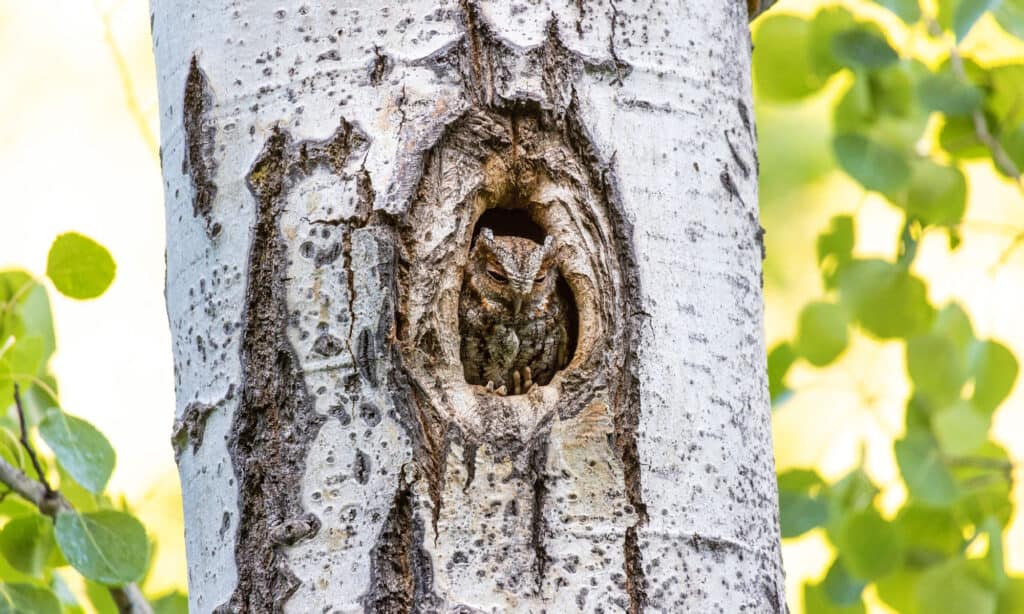
A tiny owl, the flammulated owl measures just 6 to 7 inches tall.
©iStock.com/Devonyu
The flammulated owl is a tiny bird about the size of a thrush. With a height of just 6 to 7 inches and a 14-inch wingspan, the flammulated owl can be difficult to spot. Its coloring makes it even more of a challenge; the flammulated owl has a mix of gray and reddish-brown feathers. It has dark, intense eyes, light eyebrows, and white spots that really make it stand out. This owl also has little ear tufts, long wings, and a short tail. As usual, even though male and female owls look super similar, the females are a bit larger.
Although small in stature, flammulated owls are fantastic at catching moths and bugs right from the air for food.
Flammulated owls love the forests in southern British Columbia, the western USA, and some parts of Mexico. Specifically, they’re often found around aspen and ponderosa pine trees. And when winter comes, they head south to warmer forests in Mexico and Central America. Interestingly, these owls often live in old woodpecker holes! Flammulated owls are not generally found in Florida, but if you’re lucky, you might be able to spot one of these tiny creatures during an evening walk.
Common Owls in Florida
Below are the common owls in Florida.
6. Short-Eared Owl (Asio flammeus)
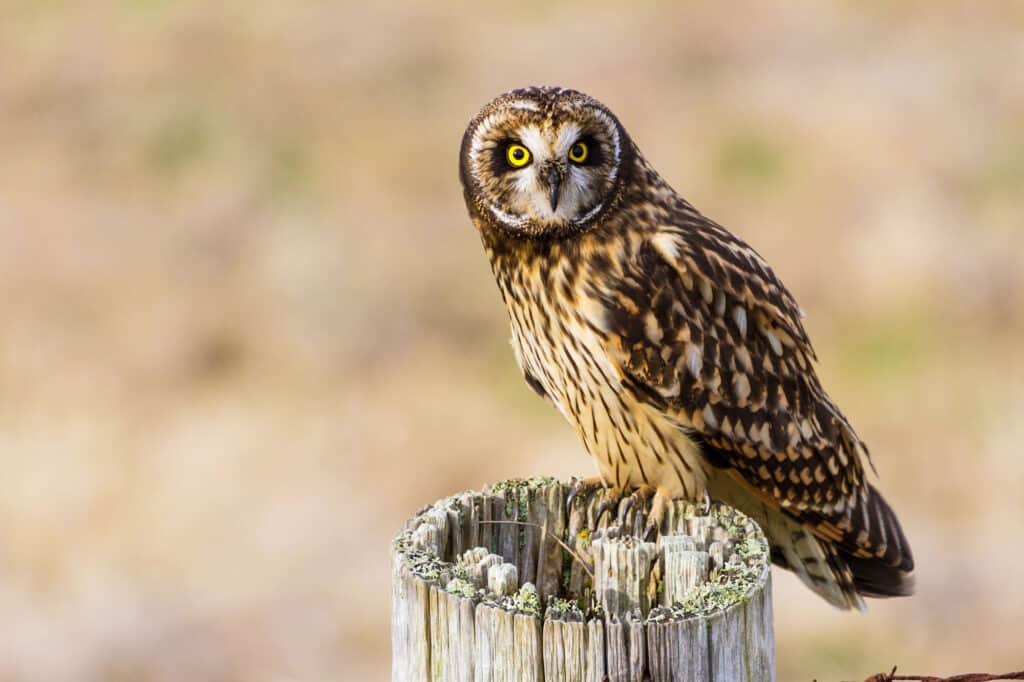
One of the more common owls you’ll see in Florida is the short-eared owl.
©iStock.com/Devonyu
Now that we have discussed the rare owls above, let’s move on to the more common owls found in Florida throughout the year.
The short-eared owl, named for its tiny ear tufts, is a medium-sized bird common in prairies, marshes, and tundras. Growing between 13 to 17 inches tall with a wingspan of 34 to 40 inches, this owl has an impressive mix of brown, buff, and white-colored feathers. The face is paler in color, with bright yellow eyes surrounded by black outlines.
What distinguishes these owls further is their nesting behavior. Unlike most owls, short-eared owls make nests on the ground, usually hiding them in tall grass. While they love eating small animals like rodents, they sometimes eat birds, too.
These owls are mostly found in Alaska, Canada, and throughout the USA. While they aren’t found in Florida year-round, they travel south when it gets cold. This means in the winter, you might be able to spot them flying around during sunrise and sunset. Unfortunately, because of habitat loss, these owls are slowly depleting in population, making their appearances in Florida even more precious.
7. Barred Owl (Strix varia)

A medium to large bird, the barred owl measures 16 to 25 inches long.
The barred owl is a medium to large bird known for its unique pattern of light and dark feathers. Typically, this owl measures around 16 to 25 inches long, with an impressive wingspan ranging from 3 to 5 feet and weighing between 1 and 2 pounds. The barred owl sports brown feathers streaked with white. Its light belly, on the other hand, has dark streaks. One of the most interesting features of the barred owl is its eyes; unlike most North American owls, the barred owl has black eyes. Additionally, this owl has a pale yellow to white beak.
Found in old deciduous, mixed, and coniferous forests, barred owls can generally be found in the eastern part of the US and southeastern Canada. Although a large bird, the barred owl can be surprisingly difficult to find as it easily blends in with the trees of deciduous forests.
In terms of food, they eat a variety of prey, from small mammals to amphibians. Although they’re pretty common in North America, including in Florida, changes to their home, like logging, do affect them. But here’s the good news: their numbers have slightly increased in recent decades.
8. Great Horned Owl (Bubo virginianus)
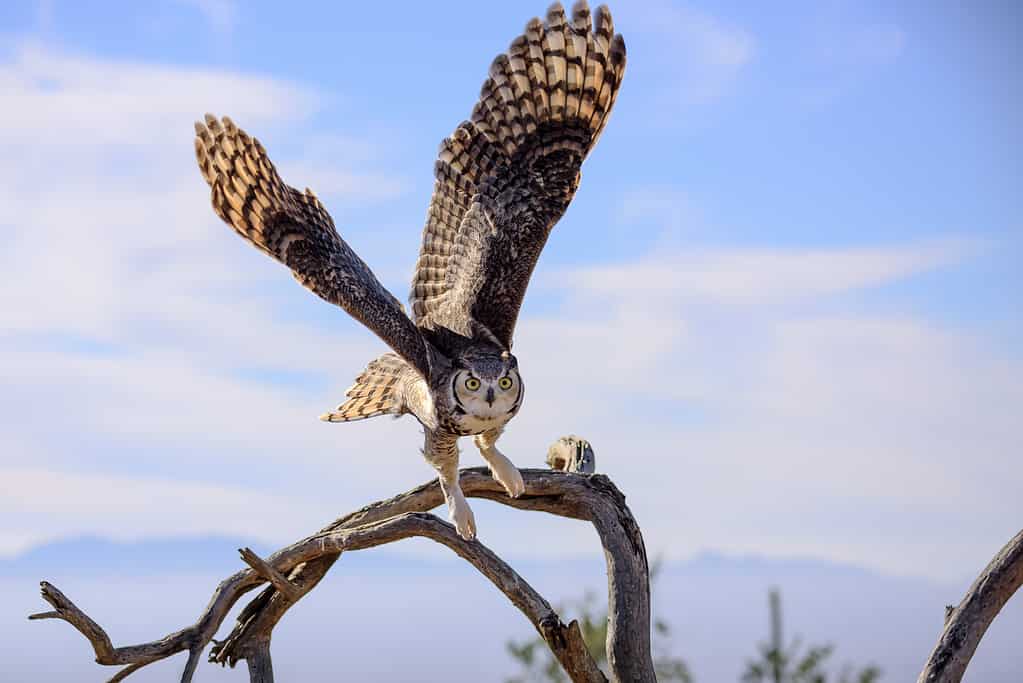
Also called the
tiger
owl, the great horned owl stands up to 2 feet tall.
©iStock.com/kojihirano
The great horned owl is a pretty impressive bird, often called the tiger owl or hoot owl. Standing around 2 feet tall and possessing a wingspan of 4.6 feet wide, this owl has cool grayish-brown feathers. Its face is a mix of reddish-brown and gray, with a standout white patch near its throat and a sharp black beak. The eyes of the great horned owl are large and yellow.
You can find these owls all over North America, including Florida and Alaska. In fact, their range can extend all the way south to South America as well! Great horned owls are not very picky about their habitat. They can be found in forests, open country, swamps, deserts… virtually all habitats in North America! However, in the breeding season, they tend to avoid open areas, as they need trees for cover.
Furthermore, when it comes to nesting, they’ll sometimes even use old buildings! When night falls, they get busy hunting, with their diet including all sorts of animals, from tiny mice to birds and even fish, scorpions, and carrion!
9. Eastern Screech Owl (Megascops asio)
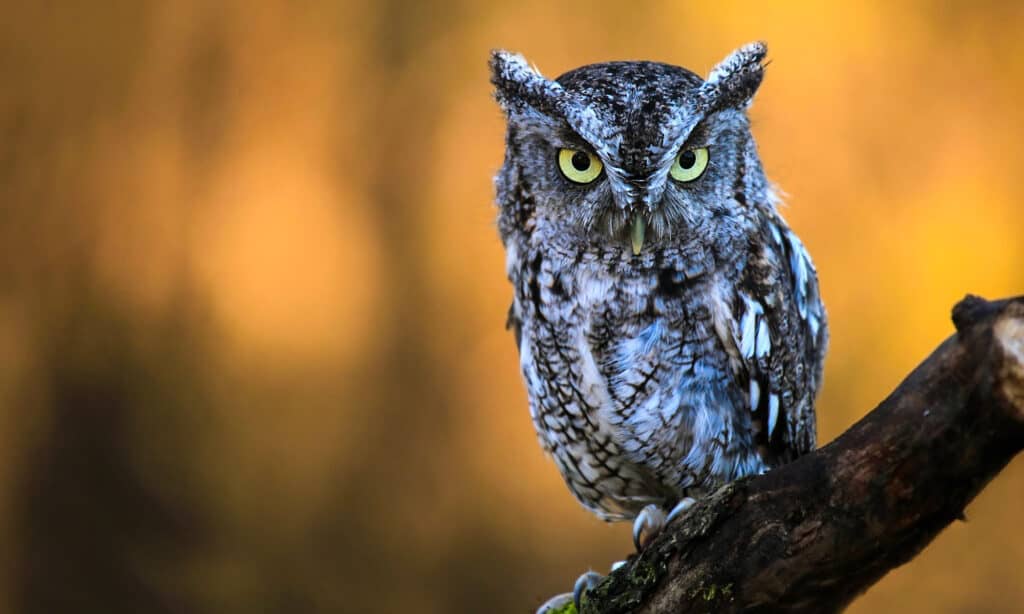
A cute-looking owl in Florida, the eastern screech owl is only 6 to 10 inches tall!
©mlorenz/Shutterstock.com
A permanent resident of Florida and the eastern United States, the eastern screech owl is a small yet striking owl. Measuring about 6 to 10 inches in size and a wingspan of 18 to 24 inches, this owl is decked out in colors ranging from gray to a lovely reddish-brown. Plus, it has stunning bright yellow eyes and feathered legs. The complicated bands and spots throughout this bird’s coloring provide excellent camouflage against tree bark. You may not be able to spot this bird if it weren’t for its yellow eyes!
A common owl east of the Rockies, you can find the eastern screech owl in woods, parks, and even suburbs – as long as there are trees! In fact, many Floridians might spot them in their backyards, usually chilling in tree holes or nest boxes. At night, these owls are super-skilled hunters. They eat a varied diet that includes insects, lizards, snakes, and little mice.
10. Barn Owl (Tyto alba)
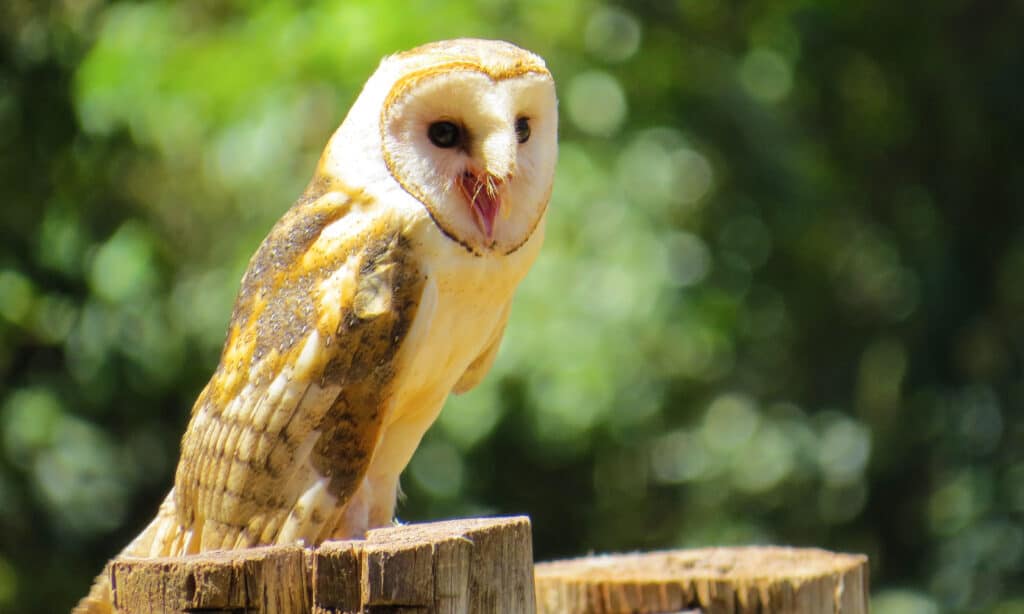
The most recognizable owl in Florida is the barn owl.
©DEBORA DUARTE LISBOA/Shutterstock.com
Probably one of the most recognizable owls in North America, the barn owl is a pretty special bird that you can see in Florida all year round. You can easily recognize this bird with its white, heart-shaped face. Measuring around 12 to 16 inches long, with a wingspan ranging between 39 and 49 inches, this bird has beautiful golden tan and gray feathers with tiny specks. A notable feature of the barn owl is that it lacks ear tufts and has a smooth head.
A common nickname for the barn owl is “ghost owl” or even “demon owl” because of its haunting screech rather than the more common “hoot.” But don’t let those spooky names fool you! This owl is super helpful because it loves eating rodents and helps keep their numbers in check.
These owls love open areas, including farmlands and prairies, but you can also find them in urban areas. You might spot barn owls hanging out in old barns, tree holes, and sometimes even in church towers! When it comes to hunting time, these owls will fly low and fast to snatch up their prey, which includes small mammals and amphibians.
Barn owls are very common in Florida. They can be found in the state all year round, with Florida barn owls laying eggs in February. In South Florida, however, they may lay more eggs again in the late summer or even fall months!
11. Burrowing Owl (Athene cunicularia)

The final owl you may come across in Florida is the burrowing owl.
©Bildagentur Zoonar GmbH/Shutterstock.com
The burrowing owl is a unique owl species that lives in Florida. You can typically find it in open spaces like farms and even some urban areas. This small owl is 7 to 11 inches long and has bright yellow eyes. The burrowing owl doesn’t have the iconic ear tufts that other owls do. They have a wingspan of 20 to 24 inches and weigh 4 to 8 oz. You’d be surprised to learn that the burrowing owl is diurnal during the breeding season, becoming primarily nocturnal when the breeding season ends. So, you have a higher chance of spotting these magnificent birds during the day from March till August. They’ve got a neat two-note hoot that sounds similar to a quail.
Burrowing owls live true to their name. Unlike other species, these owls don’t live in trees. Instead, they live underground, often in holes made by other animals like prairie dogs. This allows them to easily catch food like insects and rodents. Interestingly, when they sense danger, they can act like rattlesnakes to scare off threats.
Unfortunately, habitat loss has caused a swift decrease in the burrowing owl population. They are currently classified as endangered.
Where and When to See Owls in Florida
Florida is home to 5 permanent owl species and several others that migrate during certain seasons. That said, owls are nocturnal, so they sleep in their nests during the day. Knowing when and where to spot them can greatly enhance your birdwatching experience.
All Year Round: Great horned owl, eastern screech-owl, barn owl, barred owl
- These owls are present throughout the year.
- Best seen at dawn or dusk in woodlands, particularly on high perches on the edge of forests overlooking open grassland or pastures.
- They may also be found in open areas, marshes, fields, and agricultural sites.
Summer: Burrowing owl
- This owl is more prevalent during the summer months, but with that said, you can still see this owl all year round, specifically the Cape Coral population.
- A great spot to see them is in urban parks with open fields
- The period from late April through June is ideal to see the chicks.
Winter: Short-eared owl
- They migrate, making their appearance in Florida during the winter.
- The Everglades and other warm areas of southern Florida are areas where you can occasionally spot them.
Rare or Accidental Sightings: Snowy owl, long-eared owl, northern saw-whet owl, flammulated owl
- These owls rarely migrate to Florida, but during years when food is scarce in their northern range, they may venture to some parts of the state.
- Keeping an eye on birdwatching forums or local birding groups might provide alerts for rare sightings.
Notable Hotspots
- The Everglades, Dry Tortugas National Park, Corkscrew Swamp Sanctuary, Ding Darling National Wildlife Refuge, Merrit Island National Wildlife Refuge, and Apalachicola National Forest are all notable places for owl spotting.
- The Great Florida Birding Trail also offers a rich birdwatching experience with a chance to spot various owl species.
Summary of the Types of Owls in Florida (From Rarest to Most Common)
| Number | Owl | Scientific Name | Rarity in Florida |
|---|---|---|---|
| 1. | Snowy Owl | Bubo scandiacus | Rare |
| 2. | Northern Saw-Whet Owl | Aegolius acadicus | Rare |
| 3. | Stygian Owl | Asio stygius | Rare |
| 4. | Long-Eared Owl | Asio otus | Rare |
| 5. | Flammulated Owl | Psiloscops flammables | Rare |
| 6. | Short-Eared Owl | Asio flammeus | Common (Winter Visitor) |
| 7. | Barred Owl | Strix varia | Common (All Year) |
| 8. | Great Horned Owl | Bubo virginianus | Common (All Year) |
| 9. | Eastern Screech Owl | Megascops asio | Common (All Year) |
| 10. | Barn Owl | Tyto alba | Common (All Year) |
| 11. | Burrowing Owl | Athene cunicularia | Common (All Year) |
The photo featured at the top of this post is © J Esteban Berrio/iStock via Getty Images
Thank you for reading! Have some feedback for us? Contact the AZ Animals editorial team.







